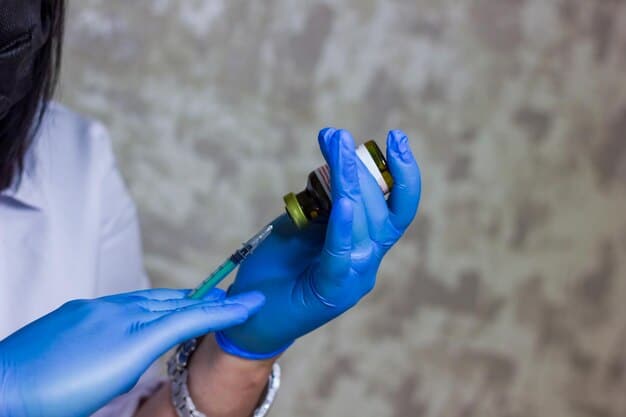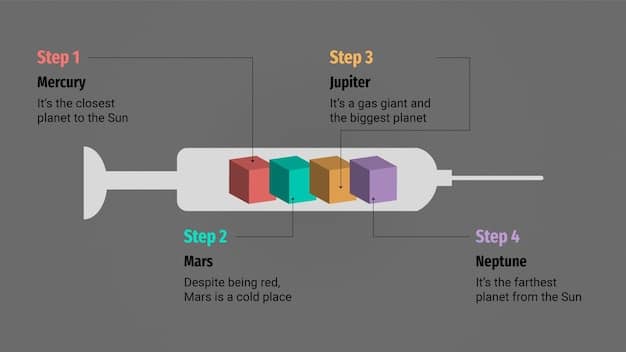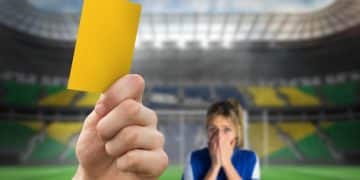FIFA’s Anti-Doping Policies: A US Player’s Guide to Compliance

FIFA’s Anti-Doping Policies: What US Players Need to Know to Stay Compliant outlines the regulations and guidelines that US soccer players must adhere to to avoid penalties. This guide explains the specifics of those policies.
Navigating the complex world of professional soccer requires more than just skill and athleticism. For US players, understanding and adhering to FIFA’s Anti-Doping Policies: What US Players Need to Know to Stay Compliant is crucial for maintaining a clean record and avoiding career-altering suspensions. Complying with these regulations ensures fair play and protects the integrity of the sport.
What are the key components of these policies, and how can US players ensure they remain compliant? Let’s explore everything you need to know.
Understanding FIFA’s Anti-Doping Regulations
To compete fairly in FIFA-sanctioned matches, understanding FIFA’s anti-doping regulations is crucial. These rules define prohibited substances and methods and detail the testing procedures players must undergo.
Key Components of FIFA’s Anti-Doping Program
FIFA’s anti-doping program is based on the World Anti-Doping Code (WADC), ensuring consistency across different sports. It includes detailed lists of prohibited substances, testing protocols, and sanctioning guidelines. Here are a few key components:
- Prohibited List: A regularly updated list identifying substances and methods banned both in and out-of-competition.
- Testing Procedures: Outlines how and when doping tests are conducted.
- Results Management: Procedures for handling adverse analytical findings and imposing sanctions.

Adhering to these components ensures that players are well-informed and compliant with FIFA’s standards. Understanding these protocols is the first step in avoiding inadvertent violations. It’s critical for US players to consult with team medical staff and independent experts to stay updated.
Specific Substances and Methods Prohibited by FIFA
Knowing which substances and methods are banned by FIFA is crucial for athletes to avoid unintentional doping violations. FIFA’s Anti-Doping Policies: What US Players Need to Know to Stay Compliant includes specific guidelines.
Classes of Prohibited Substances
FIFA’s regulations prohibit several categories of substances. These include anabolic agents, peptide hormones, growth factors, beta-2 agonists, and diuretics, among others. Each category carries significant risks and is strictly monitored during testing.
- Anabolic Agents: Enhance muscle growth and strength.
- Peptide Hormones: Stimulate the production of certain hormones in the body.
- Beta-2 Agonists: Used to treat asthma but can enhance performance.
Prohibited Methods
In addition to substances, specific methods are also prohibited. These include blood doping, gene doping, and any form of manipulation of samples. Such methods compromise the accuracy of testing and create an unfair advantage.
Understanding these prohibited substances and methods is vital for clean athletes. Regularly reviewing the updated lists and educating oneself about the risks can prevent accidental breaches of anti-doping rules. For US players, this knowledge safeguards their careers and upholds the sport’s integrity.
Testing Procedures: What US Players Can Expect
Knowing what to expect during anti-doping tests can help reduce anxiety and ensure US players fully comply with FIFA’s procedures. FIFA’s Anti-Doping Policies: What US Players Need to Know to Stay Compliant details various aspects of the testing process.
In-Competition vs. Out-of-Competition Testing
FIFA conducts doping tests both during and outside of competitions. In-competition tests usually occur immediately after a match, while out-of-competition tests can take place at any time and location. The main differences include:
- Timing: In-competition tests are event-related, while out-of-competition tests are unannounced.
- Notification: Players are notified immediately after a match for in-competition tests, unlike the surprise nature of out-of-competition testing.
- Focus: In-competition testing aims to detect immediate performance enhancement, while out-of-competition testing assesses long-term substance use.
The Testing Process Step-by-Step
The testing process usually involves several steps:
- Notification: A doping control officer notifies the player of selection for testing.
- Sample Collection: The player provides a urine or blood sample under supervision.
- Laboratory Analysis: The sample is sent to a WADA-accredited lab for analysis.
Understanding each step is critical. US players should ensure they follow all instructions meticulously during notification and sample collection. Maintaining awareness of their rights and responsibilities helps ensure a smooth and compliant testing experience.

US Player Rights and Responsibilities
Navigating the anti-doping landscape requires US players to understand their rights and responsibilities. Respecting these guidelines ensures a fair testing process and protects athletes from potential violations.
Rights of US Players During Doping Control
US players have several rights during doping control, including the right to:
- Have a representative present during the testing process.
- Receive clear information about the testing procedure.
- Request a delay for valid reasons such as medical conditions.
Responsibilities of US Players
US players also have the following responsibilities:
- Be available for testing at any time.
- Declare any medications or supplements being used.
- Cooperate fully with doping control officers.
Knowing their rights and fulfilling their responsibilities ensures a fair and respectful anti-doping process. US players should seek advice from legal or medical representatives if they feel their rights have been violated. Upholding these standards safeguards the integrity of both the athlete and the sport.
Consequences of Anti-Doping Rule Violations for US Players
The consequences of violating anti-doping rules can be severe and career-altering. Understanding the potential sanctions helps US players appreciate the importance of FIFA’s Anti-Doping Policies: What US Players Need to Know to Stay Compliant.
Types of Sanctions
Sanctions for anti-doping rule violations vary based on the severity and nature of the offense. Common sanctions include:
- Suspensions: Temporary or permanent bans from participating in soccer.
- Fines: Monetary penalties for violations.
- Disqualification: Loss of medals, points, and other awards.
Appeals Process
Players have the right to appeal sanctions imposed. The appeals process typically involves presenting evidence and arguments to an independent tribunal. It’s essential to consult legal counsel to navigate this process effectively.
The consequences of anti-doping violations extend beyond individual athletes. Violations damage the reputation of the sport and erode trust among fans and stakeholders. Compliance with anti-doping rules is crucial for preserving integrity and fair play. US players should strive to stay informed and compliant to avoid these severe repercussions.
Staying Compliant: Practical Advice for US Players
Staying compliant with FIFA’s anti-doping policies requires ongoing education and proactive measures. Having the practical steps and advice can help US players ensure they adhere to regulations.
Consulting Medical Professionals
Regular consultations with medical professionals are essential. Team physicians and sports medicine experts can provide the latest information on prohibited substances. This guidance minimizes the risk of inadvertent violations.
Supplement Awareness
Supplements can pose a significant risk due to potential contamination with prohibited substances. US players should exercise caution and choose supplements that have been third-party tested for purity and safety.
Staying compliant involves continuous effort and vigilance. US players should prioritize education, seek expert advice, and maintain meticulous records to ensure they are always following FIFA’s Anti-Doping Policies: What US Players Need to Know to Stay Compliant. Doing so preserves their careers and upholds the integrity of the sport.
| Key Point | Brief Description |
|---|---|
| ⚽ Prohibited Substances | Awareness of banned substances to prevent unintentional doping. |
| 🧪 Testing Procedures | Understanding in and out-of-competition testing protocols. |
| ⚖️ Player Rights | Knowing rights during doping control, including representation. |
| 🚫 Consequences | Understanding the severe penalties for anti-doping violations. |
Frequently Asked Questions (FAQ)
The primary goals are to maintain fair play, protect players’ health, and ensure the integrity of soccer globally by preventing doping.
The list is typically updated annually, but interim updates may occur if new substances are identified. Players should regularly check the latest version.
If a test is positive, the player may face sanctions, including suspensions, fines, and disqualification depending on the substance and other factors.
Yes, players have the right to appeal any doping sanction. The appeals process usually involves presenting evidence to an independent tribunal.
Players can consult the official FIFA website, team medical staff, or legal representatives specializing in sports law for detailed guidance and advice.
Conclusion
In conclusion, understanding and adhering to FIFA’s Anti-Doping Policies: What US Players Need to Know to Stay Compliant is crucial for maintaining a clean and successful soccer career. Staying informed and compliant ensures protects fair play and upholds the integrity of the sport.
By prioritizing education, seeking guidance from medical professionals, and carefully managing supplement use, US players can navigate the anti-doping landscape with confidence. The commitment ensures their well-being and the sport’s reputation.





